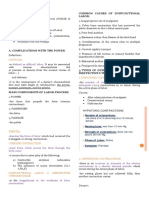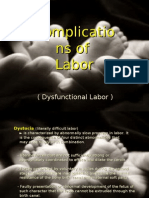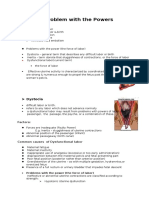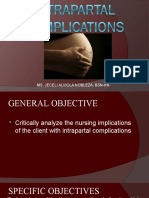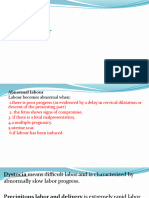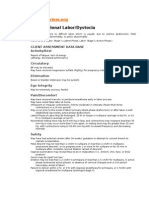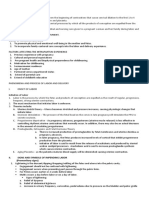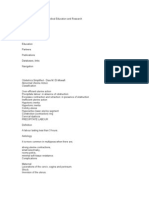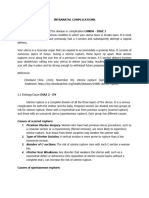Dystocia Due To Abnormalities To Powers: Uterine Dysfunction
Dystocia Due To Abnormalities To Powers: Uterine Dysfunction
Uploaded by
CT Johara MusorCopyright:
Available Formats
Dystocia Due To Abnormalities To Powers: Uterine Dysfunction
Dystocia Due To Abnormalities To Powers: Uterine Dysfunction
Uploaded by
CT Johara MusorOriginal Description:
Original Title
Copyright
Available Formats
Share this document
Did you find this document useful?
Is this content inappropriate?
Copyright:
Available Formats
Dystocia Due To Abnormalities To Powers: Uterine Dysfunction
Dystocia Due To Abnormalities To Powers: Uterine Dysfunction
Uploaded by
CT Johara MusorCopyright:
Available Formats
DYSTOCIA DUE TO ABNORMALITIES TO Dystocia is the most common contemporary indication for
POWERS primary cesarian section.
The recommendations of the American College of
Obstetricians and Gynecologists that the cervix be dilated
Uterine Dysfunction to 4 cm or more before a diagnosis is made. The diagnosis of
dystocia is often made before the active phase of labor and thus,
Hypotonic Uterine Dysfunction
before an adequate trial of labor. Cesarian sections done for
Hypertonic Uterine Dysfunction dystocia in the latent phase of labor are inappropriate.
Complications and Management Factors which have been implicated in the increased use of
cesarian delivery for dystocia include incorrect diagnosis of
Active Management of Labor dystocia, epidural analgesia, fear of litigation, and even
clinical convenience. Insufficient oxytocin stimulation of
Abnormal Labor Patterns
labor is also another factor implicated.
Prolonged Latent Phase
Protraction Disorders
UTERINE DYSFUNCTION
Arrest Disorders
Failure of the cervix to dilate or the presenting part to
Precipitate Labor and Delivery descend is cause for concern. Uterine dysfunction in any
phase of cervical dilatation is characterized by lack of
Inadequate Voluntary Expulsive Force progress.
The management of uterine dysfunction has changed from
the attitude of watchful waiting to a more aggressive
DYSTOCIA
approach brought about by the 1) realization that undue
or difficult labor is characterized by abnormally slow prolongation of labor may contribute to perinatal morbidity and
progress of labor mortality, 2) use of dilute solutions of intravenous oxytocin in
certain types of uterine dysfunction, and 3) more frequent use of
cesarian delivery rather than difficult midforceps delivery when
oxytocin fails or is inappropriate.
The four abnormalities that may exist singly or in
combination and result in dystocia are: Uterine contractions of normal labor are characterized by a
gradient of myometrial activity; being greatest and lasting
1. Abnormalities of the expulsive forces
longest at the fundus (fundal dominance) and diminishing
a. Uterine dysfunction- uterine forces insufficiently towards the cervix.
strong or not appropriately coordinated to efface and dilate
In addition to a gradient of activity, there was a time
the cervix
differential in the onset of the contractions in the fundus,
b. Inadequate voluntary muscle effort during the midzone and lower uterine segments when small balloons
second stage of the fetus were inserted into the myometrium at various levels and
attached to strain-gauge transducers.
2. Abnormalities of presentation, position or
development of the fetus The stimulus starts in one cornu and then several
milliseconds later in the other, the excitation waves then
3. Abnormalities of the maternal bony pelvis- pelvic joining and sweeping over the fundus and down the uterus.
contraction
The lower limit of contraction pressure required to dilate the
4. Abnormalities of the birth canal other than those of cervix is 15 mmHg. The normal spontaneous contractions often
the bony pelvis that form an obstacle to fetal descent exert pressures of about 60 mmHg.
Pelvic contraction is often accompanied by uterine TYPES OF UTERINE DYFUNCTION
dysfunction and the two constitute the most common
cause of dystocia. 1. Hypotonic Uterine Dysfunction- is characterized by
absence of basal hypertonus, presence of a normal gradient
Abnormalities in presentation, position and development pattern with fundal dominance, but the slight rise in
may also be accompanied by uterine dysfunction. pressure during a contraction is insufficient to dilate the
As a general rule: uterine dysfunction is common whenever cervix at a satisfactory rate.
there is disproportion between the presenting part of the Contractions become less frequent and the uterus is
fetus and the birth canal easily indentable at the height of a contraction.
It usually occurs in the active phase of labor after the The Society of Obstetricians and Gynecologists of Canada
cervix has dilated to more than 4 cm. This type of (SOGC) recommends the following protocol: Initial dose of
dysfunction often responds favourably to treatment with oxytocin of 1-2 mU/ minute, increase interval of 30 minutes,
oxytocin. and dosage increment of 1-2 mU. The usual dose for good labor
is 6-12 mU/ minute.
2. Hypertonic Uterine Dysfunction- or incoordinate
uterine dysfunction is characterized by basal hypertonus
with distorted pressure gradient because of absence of
fundal dominance or by complete asynchronism of the The following precautions are exercised with the use of
impulses originating in each cornu, or a combination of oxytocin stimulation:
these two. 1. The woman should be in true labor with the cervix at least
The contractions are painful but ineffective. 4cm dilated.
The use of oxytocin in this type of dysfunction will 2. Cephalopelvic disproportion and any abnormalities of the
usually result in accentuation of abnormal pattern of birth canal must be ruled out.
uterine contractions and increase in uterine tone. This 3. Oxytocin is avoided in the presence of abnormal fetal
will usually respond to sedation. presentation and marked uterine overdistention as in
hydramnios and multifetal pregnancy.
COMPLICATIONS OF UTERINE DYSFUNCTION 4. Women above 35 years, more than para 5 and those with
previous uterine scars are generally not given oxytocin
1. Fetal and neonatal death. because of the danger of rupture.
2. Intrauterine infections in prolonged dysfunctional labor 5. The condition of the fetus must be good- no meconium
stained amniotic fluid, normal fetal heart rate
3. Maternal exhaustion
6. Patient must be watched very carefully for sign of
4. Difficult labors and deliveries are likely to leave hyperstimulation (more than 5 contractions in 10 minutes),
psychological scars on the mother which may affect future which will necessitate discontinuation of oxytocin infusion.
childbearing.
7. Continuous electronic monitoring of fetal heart and uterine
contractions.
TREATMENT OF HYPOTONIC UTERINE
DYSFUNCTION
ACTIVE MANAGEMENT OF LABOR
Before a treatment plan can be formulated, it must be
ascertained that the woman is in active labor with the Labor is diagnosed when painful contractions are
cervix at least 4cm dilated and cephalopelvic disproportion accompanied by complete cervical effacement, bloody show,
must be ruled out. or spontaneous rupture of membranes.
A contracted pelvis is most unlikely with clinical findings of Onset of labor is considered to begin with admission and
1) normal diagonal conjugate, 2) pelvic sidewalls nearly parallel, progress of cervical dilatation is noted at 1 hour interval for
3) ischial spines not prominent, 4) sacrum not flat, 5) subpubic the first three hours and every two hours thereafter.
angle not narrow, 6) occiput is the presenting part, and 7) fetal
head is engaged. The slowest acceptable rate is 1cm per hour. Lack of
acceptable progress is treated with oxytocin using the high
Once the diagnosis of active labor followed by hypotonic dose regimen. Oxytocin is started at a dosage of 6 mU/ min
uterine dysfunction has been made, amniotomy is done and advanced in 6 mU/ min increments.
to determine the character of the amniotic fluid. The
patient is then closely observed for 30 to 50 minutes to see Duration of labor in the hospital is equated with time spent
whether amniotomy will improve uterine contractions, in the labor unit, which should not exceed 12 hours. After
after which a decision is made whether to do cesarian this period, cesarian section is performed unless safe vaginal
section or to stimulate labor with oxytocin. delivery could be predicted within the hour.
Active management of labor is not associated with untoward
maternal or neonatal outcomes. It may lead to shortened labor
OXYTOCIN STIMULATION in nulliparous women but has not consistently led to a reduction
in cesarian deliveries.
Traditionally: 10 units of oxytocin are incorporated in 1 liter of
dextrose or lactated Ringer’s solution and infused at a rate of 1
milliunit per minute initially and titrated against uterine
contractions, with increments of 1 milliunit every 30 minutes TREATMENT OF HYPERTONIC UTERINE
when necessary. DYSFUNCTION
Hypertonic uterine dysfunction is characterized by uterine pain
that appears out of proportion to the intensity of the contraction
and their effectiveness in effacing and dilating the cervix. PROTRACTION DISORDERS
Placental abruption must always be considered as a Protracted active phase dilatation means that the maximum
possible cause of uterine hypertonus. Cesarian delivery slope of dilatation is less than 1.2 cm per hour in nulliparous or
must be employed if fetal distress is suspected. 1.5 cm per hour in multiparous women.
If membranes are intact and there is no evidence of Protracted descent means descent of the fetal head is
fetopelvic disproportion or fetal distress, the woman may less than 1 cm per hour in nulliparous or 2 cm per hour in
be sedated with morphine or meperidine to relieve pain multiparous women.
and rest the mother as well as arrest abnormal uterine Possible etiologic factors: malposition, excessive sedation,
activity, after which it is hoped that more effective labor conduction analgesia and cephalopelvic disproportion
will be established.
28% of these women have CPD and require cesarian
section. If CPD has been ruled out, the therapy
ABNORMAL LABOR PATTERNS recommended is physical and emotional support, and a
prolonged labor can be anticipated.
Friedman defined seven types of dysfunctional labor, each
of which occurs singly or in combination with the other One should guard against the temptation to effect
disorders. instrumental delivery. Continuous fetal monitoring is
essential.
Prolonged latent phase, protracted active phase
dilatation, protracted descent and prolonged
deceleration phase are qualitatively indistinguishable ARREST DISORDERS
from normal labor in that they follow the general shape of
dilatation or descent pattern. Before the arrest disorder can be diagnosed in the first
stage of labor, the ACOG (1995) suggested that the
They differ from normal only in a strict quantitative sense, following criteria should be met: 1) the latent phase is
falling outside the normal range of some specific phase completed (i.e., cervical dilatation is a minimum of 4 cm), and 2)
duration or shape. the uterine contraction pattern exceeds 200 Montevideo units
Secondary arrest of dilatation involves a pattern for two hours without cervical change.
change from the expected sigmoid shaped curve of cervical In assessing the optimal contraction pattern, the effect of
dilatation. Progressive dilatation in the active phase stops anesthesia should be considered.
before full cervical dilatation is attained.
Secondary arrest of dilatation occurs when cervical
Arrest of descent also involves a pattern change, with cessation dilatation stops in the active phase (maximum slope) for 2
of progressive linear descent occurring most often in the second hours or more.
stage of labor when the head is beyond station 0. Usually, 1
hour of arrest of descent is sufficient to make a diagnosis of this Prolonged deceleration phase occurs when it lasts longer
disorder. than 3 hours in nulliparas or 1 hour in multiparas.
Failure of descent is diagnosed in the deceleration phase or Arrest of descent is cessation of descent progression in the
during the second stage when active descent is expected to pelvic division of labor for 1 hour or more.
be in full progress but has not occurred. The station of the
Failure of descent is lack of expected descent during the
head remains high and does not go beyond station 0.
pelvic division with the head at station 0 or above.
Most patients (52%) with arrest disorders have CPD and
PROLONGED LATENT PHASE require cesarian delivery. Other etiologic factors include
hypotonic uterine dysfunction, malposition, excessive
A prolonged latent phase is one longer than 20 hours in sedation and anesthesia.
nulliparous or 14 hours in multiparous women.
Prolonged second stage is diagnosed in nulliparous women
Etiologic factors: excessive sedation or conduction who experience lack of continuing progress for 2 hours
analgesia, unfavourable cervix (e.g. thick, rigid, uneffaced, without or 3 hours with regional anesthesia. It is diagnosed
undilated). false labor and uterine dysfunction in parous women who experience lack of progress for 1
Most women with prolonged latent phase are already hour without or 2 hours with regional anesthesia.
thoroughly exhausted and may suffer from fluid and
electrolyte imbalance.
PRECIPITATE LABOR AND DELIVERY
If there is no contraindication for a 6-10 hour delay of delivery, a
therapeutic rest is recommended using strong sedatives. Precipitate labor terminates in expulsion of the fetus in less
than 3 hours. Precipitate dilatation is diagnosed when the
maximum slope of dilatation is more than 5cm per hour in INADEQUATE VOLUNTARY EXPULSIVE FORCE
nulliparas or 10 cm per hour in multiparas.
When the woman in labor reaches full cervical dilatation
This may result from an abnormally low resistance of the with descent of the head, she starts to bear down every
soft parts of the birth canal, from abnormally strong uterine time the uterus contracts. The combined force created by
abdominal contractions, or very rarely, from absence of the contractions of the uterus and the abdominal
painful sensations and thus, a lack of awareness of vigorous musculature propels the fetus down the vagina and through
labor. the vaginal outlet.
Short labors were associated with abruption (20%), The magnitude of the force created by contractions of the
meconium, postpartum hemorrhage, cocaine abuse, and abdominal musculature may be compromised and prevent
low Apgar scores. spontaneous vaginal delivery when the patient has been
given conduction analgesia (lumbar, epidural, caudal, or
intrathecal), general anesthesia, or heavy sedation.
MATERNAL EFFECTS
Precipitate labor and delivery are seldom accompanied by MANAGEMENT
serious maternal complications if the cervix is effaced
appreciably and easily dilated, the vagina has been stretched Careful selection of the kind of analgesia and the timing of
previously, and the perineum is relaxed. its administration are important to avoid compromise of
voluntary expulsive efforts.
Conversely, vigorous uterine contractions combined with a
long, firm cervix and a vagina, vulva or perineum that resists With rare exceptions, intrathecal analgesia or general
stretch may lead to rupture of the uterus or extensive anesthesia should not be administered until all conditions
lacerations of the cervix, vagina, vulva or perineum. for a safe outlet forceps delivery have been met.
It is in these latter conditions that amniotic fluid embolism With continuous epidural analgesia, it may be necessary to
is most likely to occur. The uterus that contracts vigorously allow the paralytic effects to wear off so that the woman
before delivery is likely to be hypotonic after delivery can generate intraabdominal pressure sufficient to move
resulting in hemorrhage from the placental implantation the fetal head into position appropriate to outlet forceps
site. delivery.
The urge to bear down is overridden by the intensification
of pain or bearing down. Long standing paralysis of the
EFFECTS ON FETUS AND NEONATES abdominal musculature as in poliomyelitis or transection of
Perinatal mortality and morbidity from precipitate labor the spinal cord may also give rise to insufficient expulsive
may be increased considerably for the following reasons: efforts.
1. The tumultuous uterine contractions prevent appropriate For the woman who cannot bear down appropriately
uterine blood flow and oxygenation of the fetal blood because of pain, analgesia is likely to be of considerable
benefit.
2. The resistance of the birth canal to expulsion of the fetal
head may cause intracranial trauma. The safest choice for both fetus and mother is nitrous
oxide mixed with equal volume of oxygen and provided
3. During an unattended birth the infant may fall to the floor during the time of each contraction. At the same time,
and be injured or may need resuscitation that is not appropriate encouragement and instruction are most likely
immediately available. to be of benefit.
TREATMENT
Unusually forceful spontaneous uterine contractions are
not likely to be modified significantly by administration of
analgesia. Any oxytoxic agents being administered should
be stopped immediately.
The use of tocolytic agents such as ritodrine and parenteral
magnesium sulphate is unproven. Use of general anesthesia
with agents that impair uterine contractility such as
halothane and isoflurane is often excessively heroic.
2. Large for the pelvic opening (macrosomia)
3. Abnormal shape (fetal tumors, acardiac co-twin)
4. Impaction of the anterior shoulder (shoulder dystocia)
ABNORMALITIES IN FETAL PRESENTATION
The fetus enters the pelvic cavity in vertex (occiput
presentation) in most cases. Any presentation other than
occiput is called ‘malpresentation’ which increases the
probability of prolonged or obstructed labor (dystocia) and
may need cesarian delivery.
DYSTOCIA DUE TO ABNORMALITIES OF
Abnormal fetal presentations that can result to dystocia
THE FETUS
include breech, shoulder, compound, and face or brow
presentation. Among these, the most common is the
breech presentation.
Abnormalities in Fetal Presentation
Breech, Shoulder, Brow, Face and Compound
BREECH PRESENTATION
Abnormalities in Fetal Position
It occurs in 3-4 % of all deliveries. It is the most common
Persistent Occiput Posterior type of malpresentation comprising 75% of malpresented
fetuses.
Persistent Occiput Transverse
A term fetus in breech presentation may even revert
Asynclitism spontaneously to cephalic presentation just prior to onset
Abnormalities in Fetal Size and Shape of labor.
Fetal Macrosomia Predisposing factors: prematurity, uterine malformations or
fibroids, polyhydramnios, very short umbilical cord,
Fetal Tumors placenta previa, fetal abnormalities (e.g. hydrocephalus,
anencephaly, neck masses, aneuploidy) and multiple
Shoulder Dystocia
gestation
Definition, Incidence, Risk Factors
Diagnosis: The “Turtle” Sign
DIAGNOSIS
Mechanism of Shoulder Dystocia
Breech presentation occurs when the buttocks and/or the
Complications: Fetal and Maternal Injuries feet are the presenting parts. On abdominal examination
(Leopold’s maneuver), the head is felt in the upper
Reduction Maneuvers abdomen and the breech in the pelvic brim.
The ‘HELPERR’ Mnemonic Auscultation locates the fetal heart higher than expected
with a vertex presentation. On vaginal examination during
The ‘ALARMER’ Mnemonic
labor, the buttocks and/or feet are felt. Thick, dark
meconium is normal.
The fetus, referred to as ‘the passenger’ plays a significant
role in the outcome of labor and delivery.
TYPES OF BREECH PRESENTATION
“Fetal dystocia” or difficult labor due to abnormalities
1. Frank (Extended) Breech: occurs when both legs are
pertaining to the fetus usually occurs in the second stage of
flexed at the hips and extended at the knees
labor characterized by prolonged duration or arrested
descent 2. Complete (Flexed) Breech: occurs when both legs are
flexed at the hips and knees
Fetal dystocia may occur when the fetus has one of the
following abnormalities: 3. Footling Breech: occurs when a leg is extended at the hip
and the knee
1. Abnormally positioned in the birth canal (malpresentation,
malposition)- collectively constitute the most common causes
of fetal dystocia occurring approximately in 5% of all labors.
MECHANISM OF LABOR
In breech presentation, the baby’s bottom (rather than the Breech presentation increases the risk of brachial plexus
feet and knees) is commonly the first to descend through injury, spinal cord birth trauma and perinatal death if
the maternal pelvis and emerge from the vagina. delivery is done by an unskilled birth attendant.
At the beginning of labor, the baby is in oblique position. As Nuchal arms, wherein one or both arms are wrapped
the baby’s bottom is the same size as the head in a term around the back of the neck complicates 0-5% of vaginal
fetus, descent occurs without difficulty. breech deliveries. This may result in neonatal trauma
including brachial plexus injury.
A delay in descent is a cardinal sign of possible problem with the
delivery of the head. Cervical spine injury can happen wen the fetus presents
with a hyperextended neck prior to delivery.
In order to begin birth, internal rotation has to occur. This
happens when the mother’s pelvic floor muscles cause the Hyperextended neck in breech (‘stargazing’ breech)
baby to turn so that it can be born with one hip directly in is present when the angle of extension of the cervical
front of the other. vertebra is more than 90°. This can be diagnosed by
ultrasound or radiologic examination.
At this point, the bitrochanteric diameter of the fetus
occupies the anteroposterior diameter of the pelvis and the Cord prolapse is common in breech presentation
baby is facing one of the mother’s inner thighs. particularly in footling type of breech. It may not always
result in severe fetal heart rate decelerations unlike when
After the delivery of the body, external rotation occurs as cord prolapse complicates a vertex presentation.
the shoulders emerge and the baby’s head enters the
maternal pelvis.
The combination of maternal muscle tone, uterine TRANSVERSE LIE AND SHOULDER
contractions and operator’s maneuvers cause the baby’s PRESENTATION
head to flex, chin to chest. Then the face emerges, and
finally the back of the baby’s head. Transverse lie and shoulder presentation occur when the long
axis of the fetus is perpendicular to that of the mother such that
the shoulder is over the pelvic inlet and becomes the presenting
part, the head in one iliac fossa and the breech in the other.
COMPLICATIONS
When the fetal long axis forms an acute angle with the
Fetal complications of breech delivery include the following: maternal axis, an oblique lie results but this is only
1. Head entrapment transitory and is referred to as an unstable lie because
when labor begins, it is converted to either longitudinal or a
2. Birth trauma (broken neck, brachial plexus injury) transverse lie.
3. Cord prolapse The common causes of transverse lie: multiparity,
pendulous abdomen, preterm gestation, placenta previa,
4. Birth asphyxia (neurologic damage)
uterine anomaly, polyhydramnios and contracted pelvis.
5. Damage to abdominal organs
DIAGNOSIS
Breech presentation is a potential problem primarily
Transverse lie can be suspected by inspection alone. The
because the presenting part is a poor dilating wedge which
abdomen is unusually wide and the fundus is only slightly
can cause the head to be trapped during delivery, often
above the umbilicus.
compressing the umbilical cord.
Fetal head entrapment may result from an incompletely
dilated cervix or from lack of time for the head to mold and
negotiate the maternal pelvis.
In a full term fetus, the bitrochanteric diameter is about the
same size as the biparietal diameter and the buttocks dilate
the cervix as effectively as the head does in vertex
presentation. However, if the baby is premature, the head
size is relatively larger than the body, so that it is possible
for the baby’s body to emerge while the cervix is not yet
fully dilated resulting to head entrapment.
Oxygen deprivation may occur and if prolonged, it may
cause permanent neurological damage.
You might also like
- Abnormal Uterine ContractionDocument75 pagesAbnormal Uterine ContractionNishaAhsin90% (20)
- DystociaDocument46 pagesDystociacoco brillqnteNo ratings yet
- Operative Vaginal DeliveryDocument6 pagesOperative Vaginal DeliveryCT Johara MusorNo ratings yet
- Ped Gi Handbook NaspghanDocument62 pagesPed Gi Handbook NaspghanFernando Camara100% (1)
- Carpal Tunnel Syndrome: A Review of LiteratureDocument7 pagesCarpal Tunnel Syndrome: A Review of Literatureanita putriNo ratings yet
- 5 DystociaDocument9 pages5 DystociaKarylle Joy WacguisanNo ratings yet
- Dystocia Dr. Cornero 2023 UPDATEDDocument13 pagesDystocia Dr. Cornero 2023 UPDATEDAngelo HuligangaNo ratings yet
- Abnormal Uterine ActionDocument8 pagesAbnormal Uterine ActionZechariah NicholasNo ratings yet
- Uterine Prolapse Is Falling or Sliding of The Womb (Uterus) From Its Normal Position Into The Vaginal AreaDocument16 pagesUterine Prolapse Is Falling or Sliding of The Womb (Uterus) From Its Normal Position Into The Vaginal AreaA sisonNo ratings yet
- Dystocia Due To Abnormalities of PowerDocument9 pagesDystocia Due To Abnormalities of PowerTJ Aquino AddunNo ratings yet
- UntitledDocument3 pagesUntitledMON RUSSEL FRIASNo ratings yet
- Abnormal Uterine ActionDocument27 pagesAbnormal Uterine Actiontanmai noolu100% (1)
- MCN Lect Module 2.5 Complications of Labor and Birth 1 and 2Document7 pagesMCN Lect Module 2.5 Complications of Labor and Birth 1 and 2AmethystNo ratings yet
- Abnormal Uterine ActionDocument9 pagesAbnormal Uterine ActionAnu ThomasNo ratings yet
- Abnormal Uterine ActionDocument69 pagesAbnormal Uterine ActionBharat ThapaNo ratings yet
- Common Causes of Dysfunctional Labor:: DystociaDocument8 pagesCommon Causes of Dysfunctional Labor:: DystociaAngelo ArabejoNo ratings yet
- Abnormal Uterine ContractionDocument34 pagesAbnormal Uterine Contractionsapana shahNo ratings yet
- Complications With The Power of LaborDocument8 pagesComplications With The Power of LaborEdrea Aquino MendezNo ratings yet
- WEEK 5-NCM-109-LECTURE-PPTX With Recorded DiscussionDocument74 pagesWEEK 5-NCM-109-LECTURE-PPTX With Recorded DiscussionMa. Isabel A. EnriquezNo ratings yet
- OB2 - Problems With The PowerDocument10 pagesOB2 - Problems With The PowerYanaNo ratings yet
- Complications During Labor and Delivery: I. Dysfunctional Labor A. DystociaDocument16 pagesComplications During Labor and Delivery: I. Dysfunctional Labor A. DystociaEden NatividadNo ratings yet
- Abnormality in PowerDocument29 pagesAbnormality in PowerGerald BatugalNo ratings yet
- Abnormality in PowerDocument29 pagesAbnormality in Powermark OrpillaNo ratings yet
- Distosia Kelainan His: Elvira Dian Islamiati IIADocument9 pagesDistosia Kelainan His: Elvira Dian Islamiati IIAFebiriani MarthaNo ratings yet
- Complication of Labor-Dysfunctional LaborDocument25 pagesComplication of Labor-Dysfunctional Laborcn351073No ratings yet
- Problem With The PowersDocument9 pagesProblem With The PowersNicole Claire LegaspiNo ratings yet
- NCM 109 Theory Module 2MDocument31 pagesNCM 109 Theory Module 2MSecreto ParabiboNo ratings yet
- Abnormal Uterine ActionDocument14 pagesAbnormal Uterine ActionSwara RamtekeNo ratings yet
- Nursing Care PlansDocument4 pagesNursing Care PlansRITIK KUMARNo ratings yet
- Intrapartal Complications - JeceliDocument70 pagesIntrapartal Complications - JeceliJeceli A. NoblezaNo ratings yet
- Distosia Karena Kelainan Power HisDocument11 pagesDistosia Karena Kelainan Power Hiselisajuniarti213No ratings yet
- Uterine Inversion Uterine Rupture Amniotic Fluid Embolism MaglangitDocument6 pagesUterine Inversion Uterine Rupture Amniotic Fluid Embolism Maglangitmaglangitjoannamarie1920No ratings yet
- Precipitate LaborDocument3 pagesPrecipitate LaborAbbeygale Galan100% (2)
- Primary Uterine InertiaDocument4 pagesPrimary Uterine InertiaTrisha Cayabyab100% (1)
- Dystocia 2010Document55 pagesDystocia 2010Meigy NitalessyNo ratings yet
- NCM 102 LectureDocument165 pagesNCM 102 LectureMelchor Felipe SalvosaNo ratings yet
- Abruptio PlacentaDocument12 pagesAbruptio PlacentaAiley DumpNo ratings yet
- Abnormal Uterine ActionDocument48 pagesAbnormal Uterine ActionKavya S Mohan0% (1)
- Uncoordinated uterine actionsDocument15 pagesUncoordinated uterine actionsAlice WankhedeNo ratings yet
- MCN ObDocument7 pagesMCN ObJoshua SaelNo ratings yet
- Displacement of The UterusDocument32 pagesDisplacement of The UterusRaja100% (1)
- Suan - Ia #5Document20 pagesSuan - Ia #5AngelicaJaneA.SuanNo ratings yet
- (Patho OB) Dystocia Due To Abnormalities in Power and Passage-Dr. Ahyong-Reyes (Bernabe)Document5 pages(Patho OB) Dystocia Due To Abnormalities in Power and Passage-Dr. Ahyong-Reyes (Bernabe)Shia LevyNo ratings yet
- Abnormal LabourDocument35 pagesAbnormal LabourAbd UlrahmanNo ratings yet
- Dysfunctional Labor DystociaDocument8 pagesDysfunctional Labor Dystocianursereview100% (4)
- Intrartum/Intrapartal Period: Phenomena and Process of Labor and Delivery I. Onset of LaborDocument14 pagesIntrartum/Intrapartal Period: Phenomena and Process of Labor and Delivery I. Onset of Laborclaireaongchua1275No ratings yet
- Abnormal Uterine ActionDocument6 pagesAbnormal Uterine ActionGhada SaadNo ratings yet
- Learning Content Women Experiencing Problems During Labor Dysfunctional Labor Secondary (Occurring Later in Labor)Document22 pagesLearning Content Women Experiencing Problems During Labor Dysfunctional Labor Secondary (Occurring Later in Labor)Ian CarodanNo ratings yet
- CN DystociaDocument7 pagesCN DystociaAlbert Francis BialaNo ratings yet
- Intrapartal Complications: Problems With The PowerDocument10 pagesIntrapartal Complications: Problems With The PowerkeinwayNo ratings yet
- Incompetent CervixDocument20 pagesIncompetent CervixTiffany AdriasNo ratings yet
- Dysfunctional Labor DystociaDocument8 pagesDysfunctional Labor Dystociamardsz100% (2)
- Prolonged LabourDocument12 pagesProlonged Labourhacker ammerNo ratings yet
- 2M Intranatal Complications - Group 2Document37 pages2M Intranatal Complications - Group 2Clarize AnneNo ratings yet
- PATHO OB DystociaDocument14 pagesPATHO OB Dystociasailor MoonNo ratings yet
- Abnormal Uterine Actions - Monika MakwanaDocument10 pagesAbnormal Uterine Actions - Monika Makwanamonika makwanaNo ratings yet
- NCM 109 Problems With Power DraftDocument3 pagesNCM 109 Problems With Power DraftJP Porras AliNo ratings yet
- Hypotonic and Hypertonic Contractions and Precipitate LabourDocument3 pagesHypotonic and Hypertonic Contractions and Precipitate LabourRebecca ApeladoNo ratings yet
- Describes Difficulty During Labor.: EtiologyDocument6 pagesDescribes Difficulty During Labor.: EtiologyRudelsa Agcolicol LangamanNo ratings yet
- Abnormal Uterine ActionDocument110 pagesAbnormal Uterine ActionAnnapurna DangetiNo ratings yet
- Obstructed LabourDocument10 pagesObstructed LabourAfra AshiqueNo ratings yet
- Painful Coitus or Dyspareunia, A Simple Guide To Causative DiseasesFrom EverandPainful Coitus or Dyspareunia, A Simple Guide To Causative DiseasesNo ratings yet
- Hernia, (Different Types) A Simple Guide To The Condition, Diagnosis, Treatment And Related ConditionsFrom EverandHernia, (Different Types) A Simple Guide To The Condition, Diagnosis, Treatment And Related ConditionsRating: 5 out of 5 stars5/5 (1)
- Lymphatic Organs and TissuesDocument3 pagesLymphatic Organs and TissuesCT Johara MusorNo ratings yet
- 50 Fun Facts About Sydney Opera HouseDocument3 pages50 Fun Facts About Sydney Opera HouseCT Johara MusorNo ratings yet
- Placenta Previa: DefinitionDocument4 pagesPlacenta Previa: DefinitionCT Johara MusorNo ratings yet
- Hypertensive DisordersDocument8 pagesHypertensive DisordersCT Johara MusorNo ratings yet
- Breech Delivery: Classification of Breech PresentationDocument1 pageBreech Delivery: Classification of Breech PresentationCT Johara MusorNo ratings yet
- Non-Invasive Antepartum Assessment of Fetal Well-Being: General Profile of Maternal HealthDocument7 pagesNon-Invasive Antepartum Assessment of Fetal Well-Being: General Profile of Maternal HealthCT Johara MusorNo ratings yet
- NCP - NCM 109 High-Risk Mother - CORITANA & ROBLESDocument4 pagesNCP - NCM 109 High-Risk Mother - CORITANA & ROBLESKimberly Almacen RoblesNo ratings yet
- Sopental Tablets Sopental CapsulesDocument2 pagesSopental Tablets Sopental CapsulesBrian HarrisNo ratings yet
- CSS-Diet For EczemaDocument32 pagesCSS-Diet For Eczemaariella krisnandaNo ratings yet
- Gluten-Free Diet TipsheetDocument2 pagesGluten-Free Diet Tipsheetapi-392216729100% (2)
- Inflammatory Bowel Diseases: Dr. Evelyn Angie M. BiomedDocument36 pagesInflammatory Bowel Diseases: Dr. Evelyn Angie M. BiomedAnnis100% (1)
- Community Based SanitationDocument4 pagesCommunity Based SanitationAnwar RosyidNo ratings yet
- Massage 1Document2 pagesMassage 1omar alaa kaiokenNo ratings yet
- Aw Aida 2018Document29 pagesAw Aida 2018FiobanaNo ratings yet
- Cupping TherapyDocument3 pagesCupping TherapyDiego Mamani Mullisaca100% (1)
- Principles of Drug Therapy For The Elderly PatientDocument16 pagesPrinciples of Drug Therapy For The Elderly PatientGalih Maygananda Putra100% (1)
- 1.2E Strabismus: ObjectivesDocument2 pages1.2E Strabismus: ObjectivesBea SamonteNo ratings yet
- Treatment of Exudative Age-Related Macular DegenerationDocument2 pagesTreatment of Exudative Age-Related Macular DegenerationAgiu BogdanNo ratings yet
- Thematic Appreciation TestDocument66 pagesThematic Appreciation Testankydeswal67% (3)
- Janku2020 Block The Light and Sleep Well Evening Blue Light Filtration As A Part of Cognitive Behavioral Therapy ForDocument13 pagesJanku2020 Block The Light and Sleep Well Evening Blue Light Filtration As A Part of Cognitive Behavioral Therapy Forpangaribuansanta100% (1)
- Medicinal Properties of Moringa Oleifera PDFDocument7 pagesMedicinal Properties of Moringa Oleifera PDFsufijinnNo ratings yet
- Effective Communication Skills: Level IIDocument84 pagesEffective Communication Skills: Level IIVandana BhagavatulaNo ratings yet
- MCQ's - Clinical ResearchDocument4 pagesMCQ's - Clinical Researchdivya83% (12)
- How Becoming A Doctor WorksDocument16 pagesHow Becoming A Doctor WorksJason RilleyNo ratings yet
- 6856 Incidence and Risk Factors of Falls and Fall Related Injuries at The Medical and Surgical Wards of The Philippine General HospitalDocument5 pages6856 Incidence and Risk Factors of Falls and Fall Related Injuries at The Medical and Surgical Wards of The Philippine General HospitalNanaNo ratings yet
- Journal of Cardiology + RomanaDocument120 pagesJournal of Cardiology + RomanaMiss Oana100% (1)
- Abdominoplasty by DR Leo Kah Woon Can Be A Near Death ExperienceDocument11 pagesAbdominoplasty by DR Leo Kah Woon Can Be A Near Death ExperienceEstee ZNo ratings yet
- What Are GallstonesDocument15 pagesWhat Are GallstonesStepyn SalvadorNo ratings yet
- Henshaw Kyle Resume UpdatedDocument1 pageHenshaw Kyle Resume Updatedapi-394341223No ratings yet
- Om Sai Ram Diet and LifestyleDocument14 pagesOm Sai Ram Diet and LifestyleSolomanTrismosinNo ratings yet
- MRI JointsDocument33 pagesMRI JointsMalaak Bassam100% (1)
- Venous Thromboembolism in Urologic Surgery: Prophylaxis, Diagnosis and TreatmentDocument25 pagesVenous Thromboembolism in Urologic Surgery: Prophylaxis, Diagnosis and TreatmentapheatNo ratings yet
- Mood Stabilizers For Bipolar Disorder in Older Adults - Special Considerations - CARLAT PUBLISHINGDocument12 pagesMood Stabilizers For Bipolar Disorder in Older Adults - Special Considerations - CARLAT PUBLISHINGWill HNo ratings yet
- Diabetes Advisor - A Medical Expert System For Diabetes ManagementDocument5 pagesDiabetes Advisor - A Medical Expert System For Diabetes ManagementPrincess LunieNo ratings yet















